
 |
We are almost a year or so away from solar maximum, the sun is getting more active and among amateur astronomers and astrophotographers a great sense of anticipation is building with the hopes of witnessing another exceptional aurora event. The sun has been living up to expectations producing regular large sunspot groups with occasional solar flares and CMEs, however as luck would have it those CMEs seemed to launch from the limb or on the far side of the sun which meant Earth never had a chance of getting hit, so despite enhanced solar activity none of it was benefiting aurora chasers.
February, March and April are the main months of the first aurora season and as time marched on we were beginning to wonder if we would get a decent aurora at all before the sky got too bright in May, after all, time was progressing swiftly and we had nothing to show for it, this would seem slightly embarrassing to admit to in the run up to solar maximum. During this period I spent less time doing photography and more time focused on visual observations of the night sky through telescopes. Each clear day I observed the solar disk in white light, counting sunspots and pores, studying faculae along the limb and admiring the umbra and penumbra of large sunspot groups many times the size of Earth. Solar observing is a fantastic hobby to engage in yet so few people indulge in this easy and highly rewarding field.
It never ceases to amaze me that you are looking at magnetic storms on a star, you are actually seeing detail on the atmosphere of our closest star, that truly is epic. The sun is a very dynamic place with features in a constant state of transition with active regions changing shape, spots vanishing and others appearing over a matter of hours and with the sun rotating once every 27 days these active regions can be seen moving across the disk with new spots appearing in the east, it really is a fascinating subject, especially in the years either side of solar maximum. I observed the sun often during February, we even observed it from different locations including a great day at Ballyronan Marina using different telescopes. I still use the same telescope I began solar observing with many years ago, my old favourite Meade 90mm ETX using the projection method. The exciting thing for the aurora hunter is, if a particular active region produces a CME which generated a major aurora which you captured on camera, then knowing that you seen that very active region with your own eyes beforehand really adds to the thrill of the experience not to mention reinforcing the science behind it all.
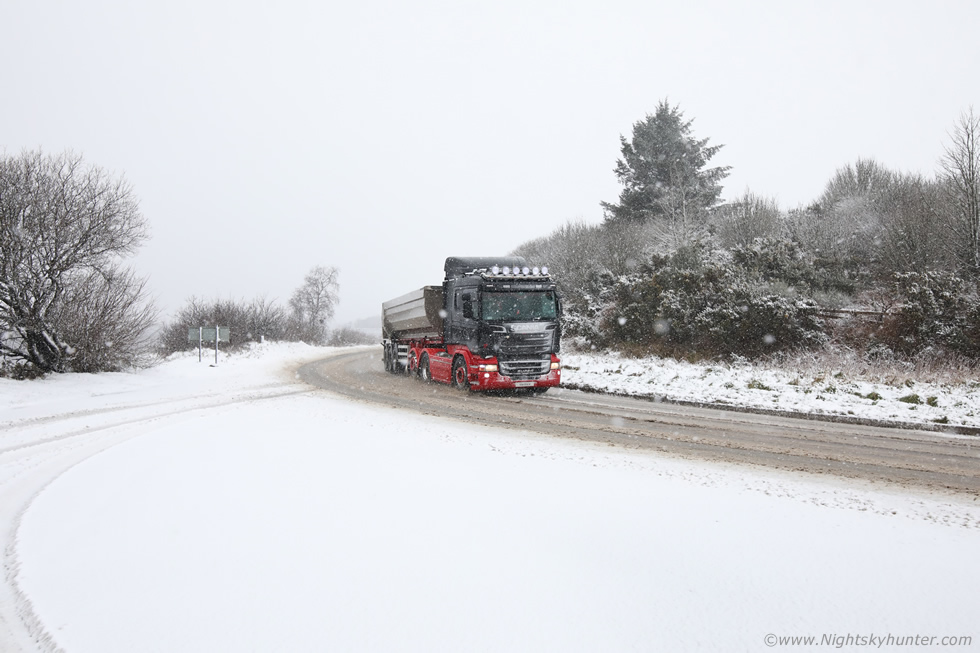 |
We had a frontal snow event on February 8th however I knew it would never amount to much due to warm temps and lack of really deep cold air. The warm front engaging this air would turn to sleet and wet snow however it would never lay on ground level, there was a chance of a brief fall on high ground but that would be it. The Sperrins and the hills of Antrim where expected to benefit from any laying snow which turned out to be the case, in fact, the Antrim hills got many inches of laying snow. I was monitoring radar all day from home, outside the window wet snow fell and melted on black tarmac, but being a self confessed snow lover I wanted to see if I could find any laying snow at all to satisfy my fix for the white gold.
My Dog Rhua and I jumped in the van and began driving towards Lough Fea for a look. As we climbed in elevation snow began laying, I was having a power issue with the van at the time so I was struggling going up the small hills on the back road due to a lack of power and wheels spun but I persevered and arrived at the lough into a winter wonderland. There was only perhaps an inch or more of snow on the ground but it was widespread and compared to low levels it as like heaven. There would be no blue skies and nice light, this was a frontal snow event so it was snowing constantly and blowing in my face, in fact, over the water there looked to be blizzard-like gusts. Rhua ran around the snow barking while I put my back to the wind and began taking images. The road was busy with trucks coming and going from the quarry so these became my subject with the snow, the drivers seemed to enjoy their image being taken, many of them waved and some blasted their air horns which made my day. After a good walk Rhua and I returned home feeling content, we had got our fix. I'm glad we did because as I write this as we approach mid March there hasn't been a hint of snow since.
On March 7th I did my first public observing night which turned out a success despite battling with cloud, we got regular clear gaps and we learned the brighter stars and constellations and observed several deep sky objects through the telescope. We even talked about the comet impact threat and stars going Supernova. A CME was supposed to hit a glancing blow this night but it never happened, it either missed or was too slow which meant it wouldn't be of interest anyway so I thought little more about it. On Sunday March 8th Roisin and I arrived home from a day out, I checked online and was surprised to see that the glancing CME, associated with a filament eruption, had arrived late and was generated a geomagnetic storm.
This peaked my interest however the storm was only at G1 levels and NOAA was only going for the same so not really exciting enough. Later things changed dramatically, the Bz stayed south all day peaking at -14. Periods of sustained southerly Bz are a big indicator that a strong aurora was possible, however to add to the confusion the solar wind speed was just over 340km/sec, actually below the average speed, so this really put me off. I began pondering what to make of it, the sky was completely clear and further clear spells were expected after dark, however based on satellite imagery the place most likely to have prolonged clear skies was the north coast. However I will admit I was exhausted from driving all day and had only just got home and the prospect of driving 1.5 hours to the coast again didn't fill me with awe, especially for a G1 aurora or glow on the horizon. But on the other hand it might be the only aurora I would get this Spring so the temptation was strong. I decided I would hold back a while and make a final decision in an hours time. In the meantime I topped up the DSLR batteries on the charger then sat in a chair, closed my eyes and rested.
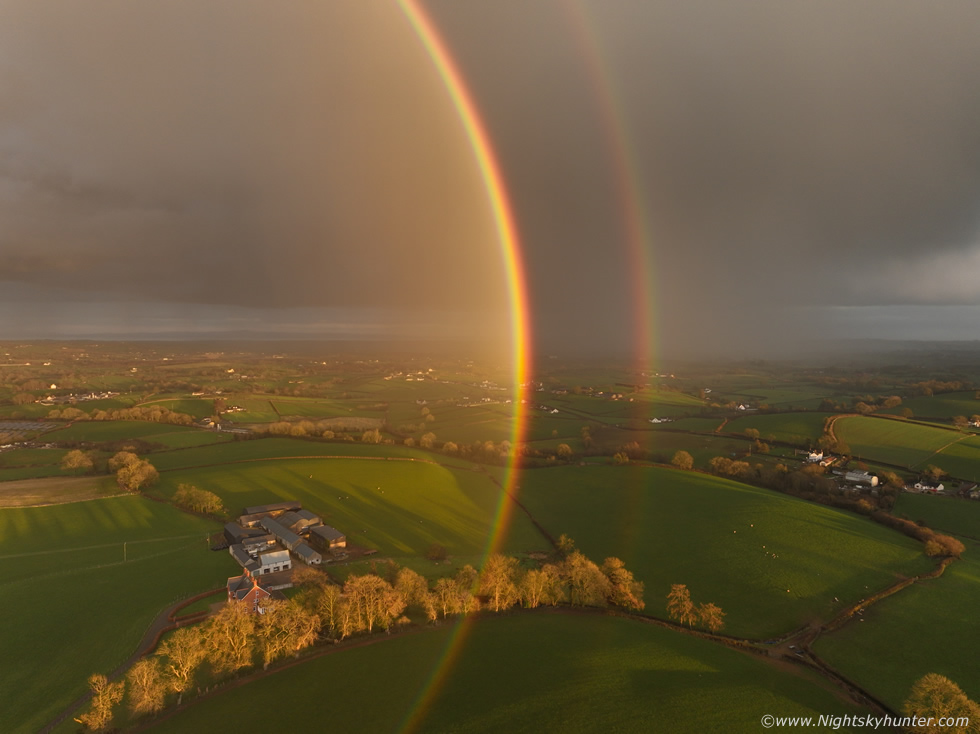 |
I had barely closed my eyes for ten minutes when Roisin yelled from upstairs saying there was a stunning primary and secondary rainbow visible. I was at first surprised as the day had been dry and sunny however I was aware of weak instability in the atmosphere so a rogue shower was certainly possible. I went out the back and was greeted by a gorgeous display, the kind that gets your adrenaline surging and makes you want to grab a camera rite away. Both bows were vibrant and visible against a dark background of heavy precipitation and the sun was partially peaking out from the cloud bathing a section of the landscape in golden light. I got the drone in the air to 120m altitude, it was still raining lightly on the drone however I knew the NE moving shower would soon clear. I began taking images and video, the bow was complete but too large to get in the FOV so I focused on the southern section which was the most photogenic.
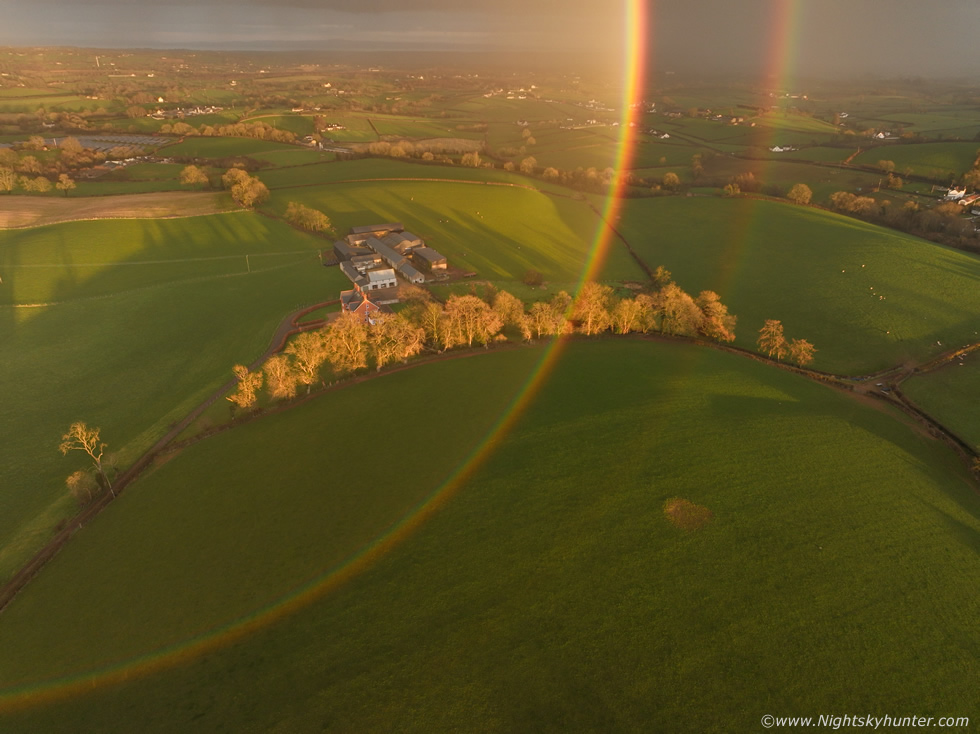 |
Panning the camera down to reveal the bow on the fields below, rainbows are actually 360 degree circles, however we only see half that circle as the ground is in the way. If you view a rainbow from a mountain top, a plane, or from a drone you get to see the full circle which is amazing to witness, I never tire of admiring rainbows by drone. When I was done with the flight I thanked Roisin for the heads-up and I felt a new sense of life about me. I was no longer tired, in fact, I felt invigorated and on a buzz from seeing that unexpected rainbow and to be honest I felt in the zone and on a roll, I knew then there was a strong chance I would be going to the coast aurora chasing.
The sky was clear and deep blue and the sun was getting lower, the kind of good quality sky which seemed to call me out. I went back inside for another check online. Weak solar wind but Bz strong and south, for many hours, I decided I was going to take the gamble and make the most of this rare opportunity. I would also bring my 10" F/5 reflecting telescope as a back-up plan so if the aurora didn't work out then I could observe the night sky, I was chasing a comet too so this would be a chance to do both from a dark location. Colleen Webb and Nigel McFarland were chasing too so we all agreed to meet on Benone beach. I packed a flask of tea, some water and snacks, the telescope, camera gear, warm clothes, topped up diesel then hit the road, it was already nearly 19.15 and it would be dark by 20.00. I don't know why but I felt a strong instinct that I was going to see something cool, this is something I can't explain, I felt it brewing all afternoon, like a form of anxiety or heightened anticipation, only of something good happening, I felt this before during the G3 aurora last November so I never ignore this feeling when it happens.
I drove north under clear skies full of promise, but once I got between Garvagh and Coleraine I was perplexed, there was a glow high in the sky through the windscreen directly in front of me, there was patchy cloud below it so at first I thought it was cloud lit up by the lights of Coleraine, then I noticed that glow was curved and shaped like an arc, I felt sure this was aurora, but surely it couldn't be with those stats? It was only when I took the turn off before Coleraine that my suspicions were confirmed, I was looking at a vibrant auroral arc. It was then I knew this was going to be good and surge of adrenaline soared through me, I couldn't wait to get to the beach. Then on cue a large lorry delivering products to spar blocked the entire road and slowly reversed into the filling station at Articlave and I was forced to wait, typical, that wait seemed like a life time but it was only five min's, then I was on my way again only this time driving faster and with purpose.
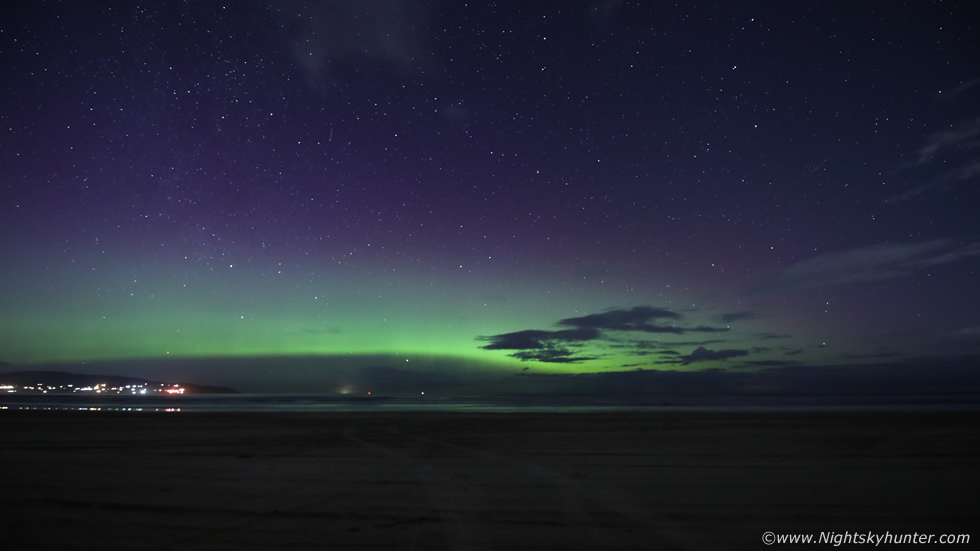 |
I arrived on Benone beach, dimmed my lights, then slowly drove across the sand until I spotted Colleen Webb's car, she was already on location setting up her camera. As soon as I parked I was out like a rocket setting up the DSLR, I was using my full frame Canon 5D Mark IV tonight with Tamron 15-30mm F/2.8 lens, I was anticipating proper action so I was staying at wide angle. I quickly got the DSLR on the tripod and began taking test images, this was the scene upon arrival, a bright arc/band was extending across the N/NW sky sector, we could discern it's green colour easily with the naked eye even without full dark adaption. My first thought was maybe the aurora had been weakening since earlier but after a long day I was glad to see something, if this was all I got then I would take it. I began shooting a time lapse, auroras can be extremely unpredictable, experienced observers know that they can suddenly
As the camera began a time lapse I set-up the 10" F/5 reflector and guided the scope to the NW for a look at M31 The Great Andromeda Galaxy, there it was in all its ghostly glory with blazing nucleus with companion galaxies M32 and M110 all sharing the same wide angle field of view. Then I moved the scope south of M31 and began a series of horizontal sweeps through Andromeda and within 30 sec's found comet 12P/Pons-Brooks. The comet was bright in the mag +6 range with a bright white central condensation, and sure enough I could easily see its type I gas tail extending downwards at an angle for 2 degrees and 15 arc min's (more than 4 apparent full moon diameters) and within the tail fine streamers fanned downwind from the coma, this night was already a success and I was buzzing.
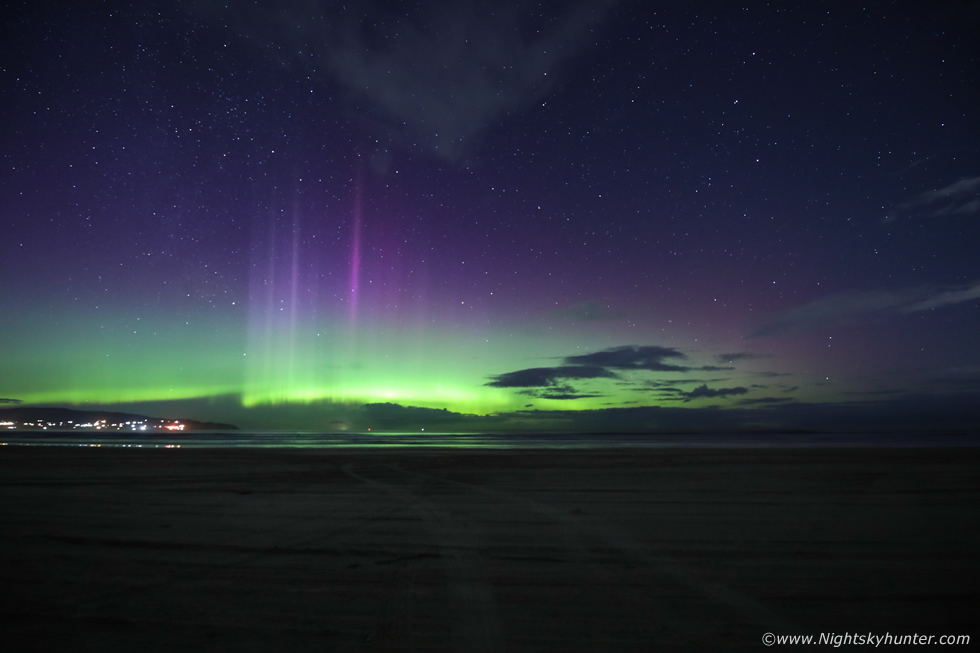 |
I suddenly heard an excited yell from Colleen, ''beams'', I abandoned the telescope and looked to the NW and sure enough within seconds large beams formed seemingly from nowhere, the aurora was in the process of going into a major outburst. At first one then many very tall slender well defined beams extended aloft with shocking magnitude blocking out the stars in northern Cygnus. Colleen and I began yelling with awe and delight, it felt like we had only just arrived and already we were getting a show.
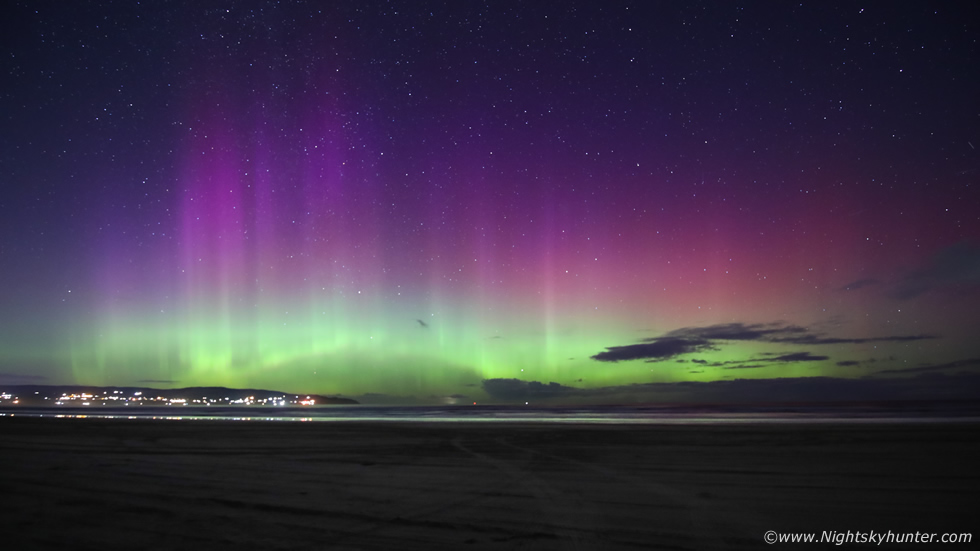 |
Within minutes we had a huge spectacular and extremely photogenic aurora in the sky, in fact, we agreed that this was easily a fully formed G2 aurora which we didn't expect at all. I was honestly expecting an arc with a few rays at best but not a fully developed dancing aurora with rays dominating the sky. We could already see green and red colours visually, the reds always higher than the green, however it was more of a subtle red like looking at a glass of red wine in low light. The camera picked up pink and purple colours thanks to the big full frame sensor. I was shocked at the structure within the green band lower down over the ocean and Donegal, it looked like multi-tiered arcs overlapping one another much in the same way as NLC forms do creating fascinating structures. Here you can see an arched bridge and to the left a complex region of interaction.
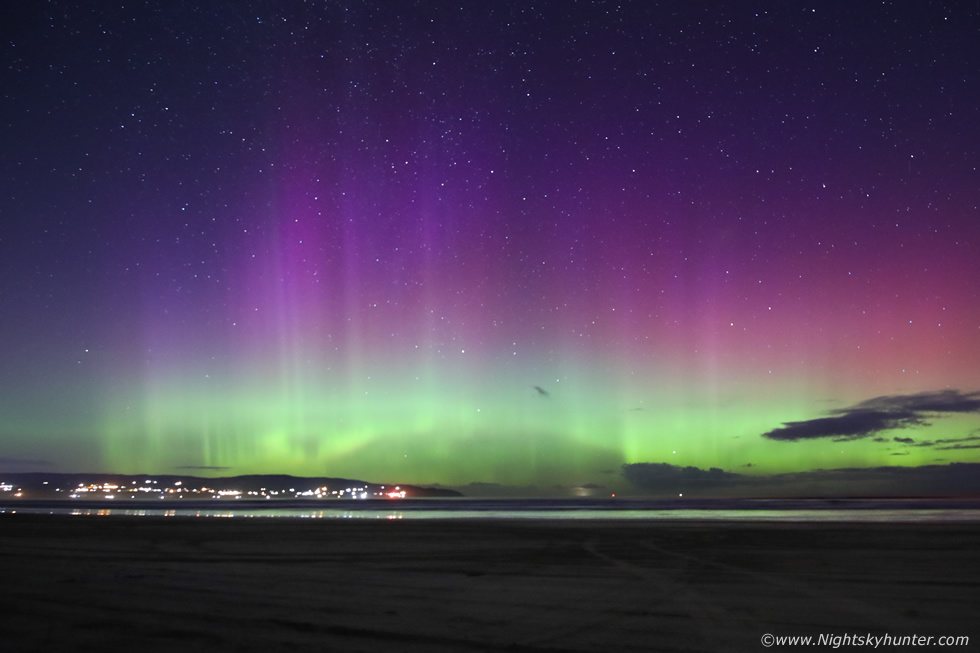 |
These are all ISO6400 at F2.8 for 6 seconds. While the aurora stole the show I took another look in the telescope to enjoy comet 12P, it was then that I noticed that the aurora was propagating eastward and began flirting with the region of sky where the comet was located within Andromeda, I could see the well formed comet and tail against a background of faint green light, the comet was now in the aurora, this was such an awesome experience. I can tell you this moment brought back fond memories from many years ago when I used to search for new comets with the 16" from Maghera. On random nights back then I would notice that the FOV looked brighter with galaxies more difficult to see, I assumed my eyepiece was misting over, then I looked up to the sky and a massive aurora was visible where I was searching, it had appeared from nowhere. At other times I recall observing faint mag +10 comets against the background of the aurora and it was an experience like no other. This is the first time I felt that rare buzz again, I was so happy I brought the telescope along.
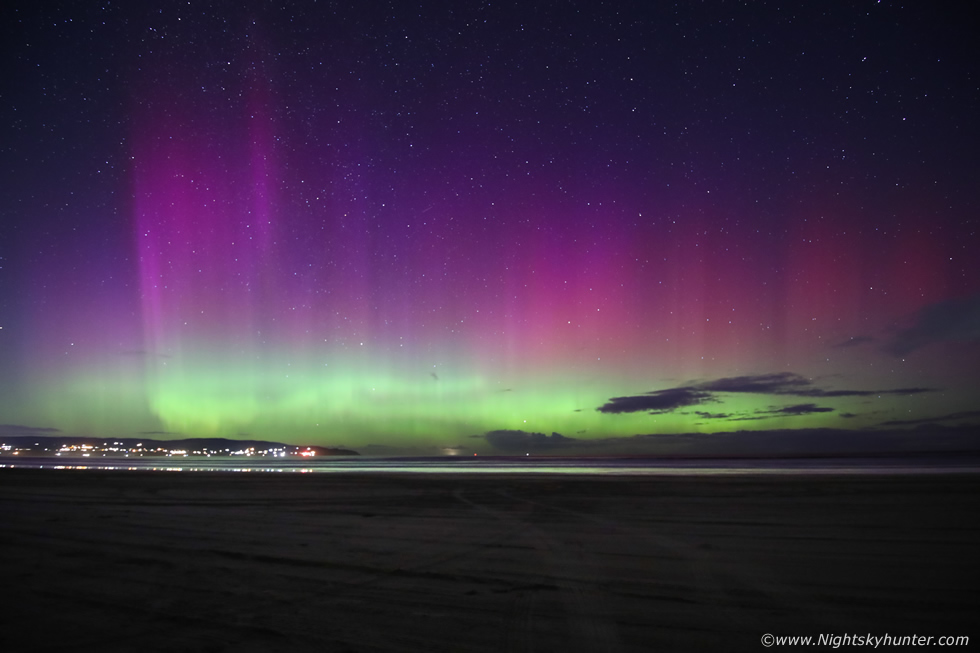 |
Then just when we thought the aurora couldn't get any better, it did, the brightness intensified and the rays grew taller and the camera was picking up vivid colours easily. Keep in mind this is 15mm wide angle on full frame, this covers a huge area of sky. The beams looked like they were alive, especially the region over Donegal, using my outstretched hand I measured their height just shy of 70 degrees, the tips of the beams were piercing Cassiopeia, in other words they where not that far from overhead.
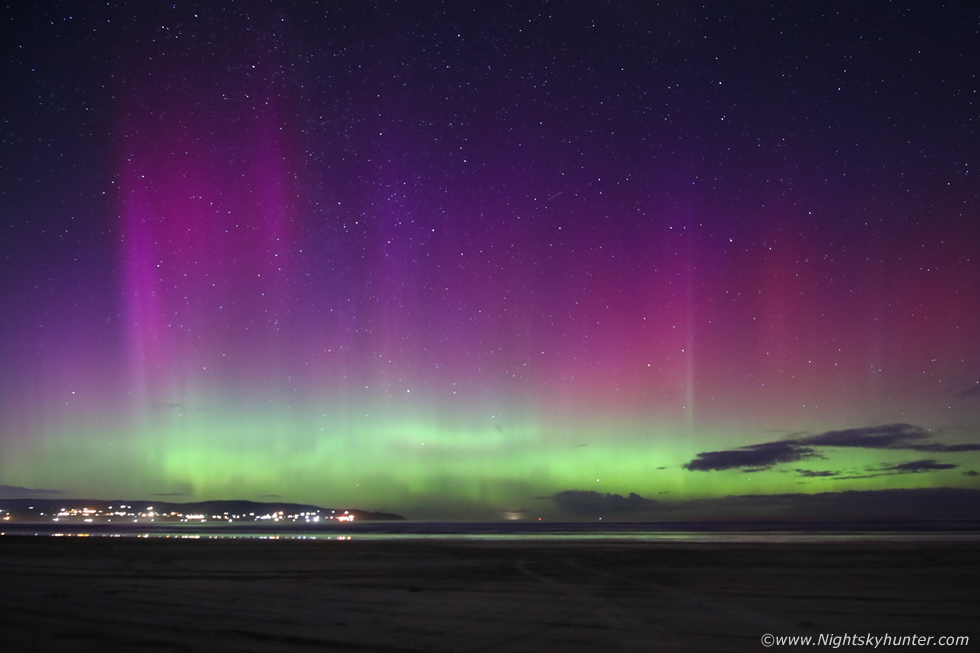 |
With the naked eye we could see green and red beams, in fact, a region to the far W outside my camera field to the left had the strongest naked eye red colour I've seen since the Beaghmore aurora of 2014, in fact, it looked like a crimson flame surrounded by orange like the glow of embers from a distant fire. This impressed me, how where we even seeing this? the stats still showed a slow solar wind speed and the Bz, while being south, wasn't exceptionally so, I was perplexed. If I had been at home looking at these stats I likely wouldn't have went out and just assumed it was a G1 with a few rays, I would never have known what I was missing. This goes to show the importance of not relying on technology too much for there really is no substitute for being out under the real sky. The only explanation I could think of was the southern Bz in conjunction with the Russel McPherron effect, in fact, March is renowned for such activity.
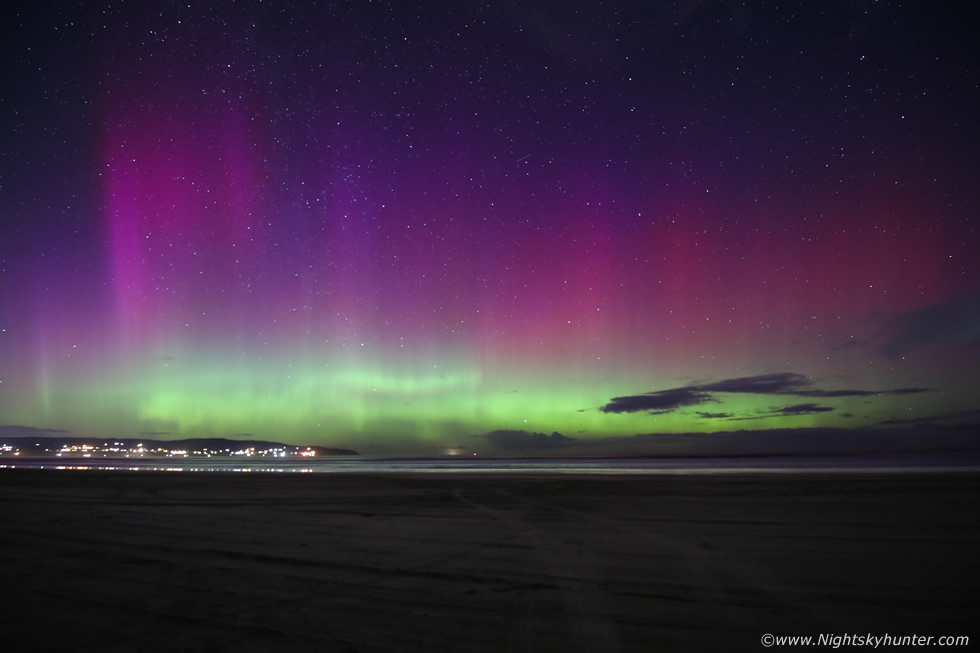 |
There were brief moments in complete honesty when the visual part of the display wasn't far off the caliber of the last G3 we observed during November last year. Then suddenly the display began to wane, lowered in height, dropped in magnitude and became a G1 again as if nothing untoward had happened. Nigel McFarland arrived, this outburst had only lasted 15 min's and he got delayed so he never got it on camera however he did see the vivid beams through his windscreen while passing the mountain road.
All three of us now stood on the beach with cameras at the ready, the next outburst could happen anytime so we watched with great anticipation. We waited for hours as the aurora perched low in the sky but still visible with the naked eye. At times it stirred with faint rays then went back to a settled band once more. Meanwhile we observed through the telescope, the dark skies were superb with excellent clarity, we had a look at M31, M32, M42, M78, Running Man nebula, I tried for the Horse Head without success but did see the nebulosity where it resided, M45, M1, M13, M81 and M82, galaxies in Leo, kept regular checks on comet 12P, I noticed that the comet had moved since we last observed it half an hour ago, there was now a bright field star within the coma. I had such a great time observing with the scope on a beach with the aurora glowing to the north the entire time, the only thing missing was a BBQ.
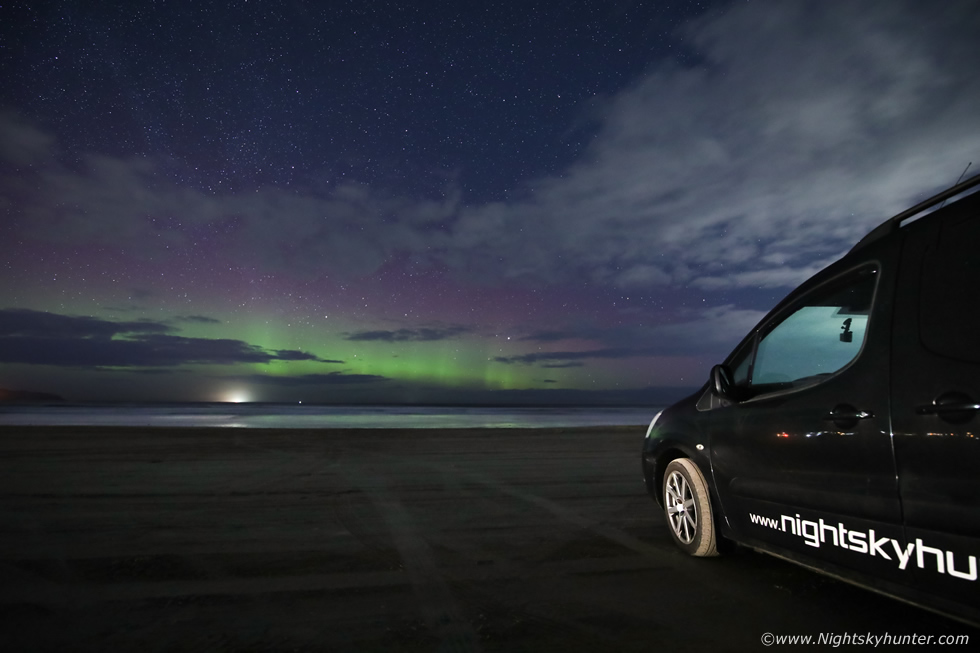 |
22.30 and the aurora was still low with faint rays, I had to include this image for the memories, I wish I had thought of taking it earlier with the large beams. I will definitely re-do this scene another time if I find myself on a flat beach during an aurora again, this is actually rare for me as I'm usually looking for foreground at places a good walk from the van. Colleen took an exposure to the SW and picked up a strange slanted red form, at first we thought it was a light reflection but then realized this was SARS, we had only ever experienced this phenomena during the G3 in November for the first time and here it was again, we didn't expect that from a storm in the G2 threshold so once again this night was offering us surprises, even when the aurora was a weak G1 that this point.
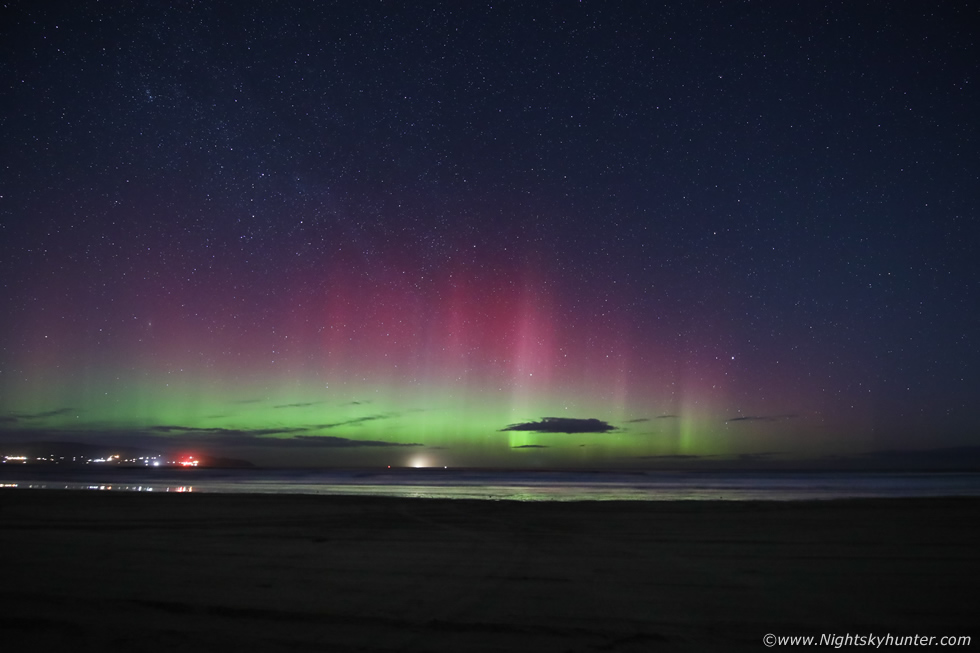 |
There were reports on social media that much of the inland countryside was covered in cloud yet at the coast we were completely clear. We were getting cold from standing so long on the sand and the tide was edging ever closer but we stuck it out, then just after 23.00 another outburst happened coinciding with a drop in the Bz to -9. Even though it was not close to the first outburst it was still great to see with nice red colours and rays 30 degrees tall, it was like the final bow from this fascinating auroral performance. The fuzzy glow
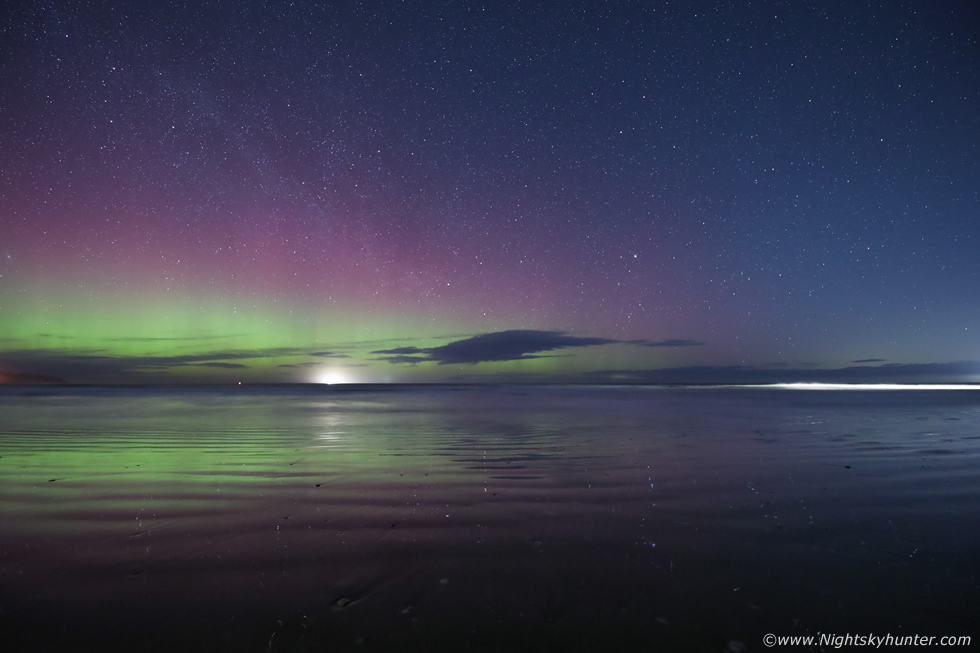 |
The tide was getting closer so we walked over to the water's edge, we could see the aurora and the brighter stars reflecting in the water. We decided to take a couple of more images for fun then we would call it a night. ISO6400 for 10 sec's.
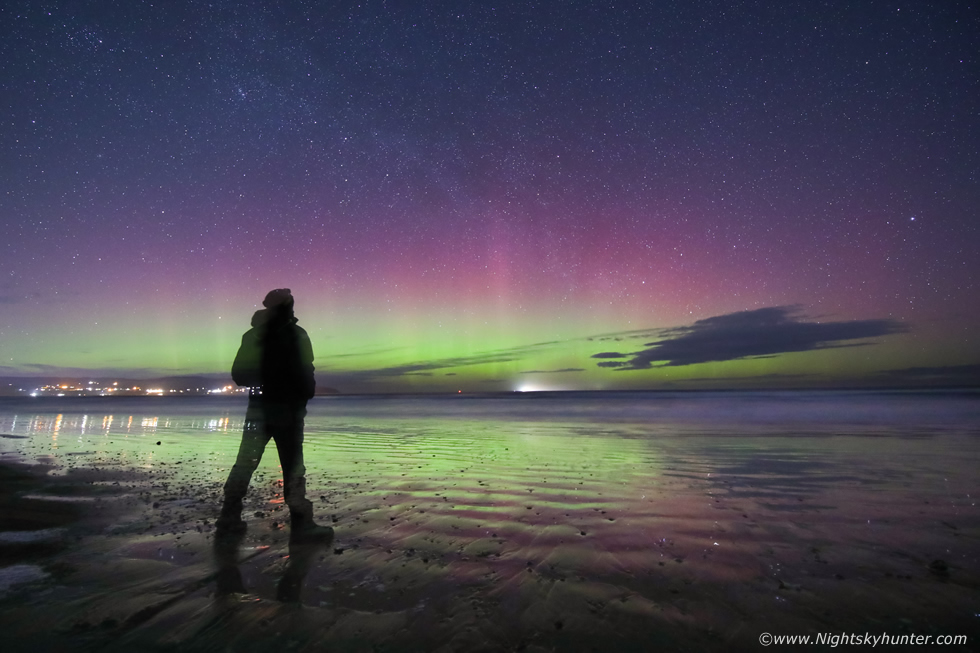 |
I had to finish with a selfie complimented by the aurora and Milky Way arching down from the upper left where it blended in with the auroral arcs. We all called it just after midnight and I began the drive home, first through fog then under high level cloud, it looked like going to the coast had been a good decision after all. I really enjoyed this session, according to my log book this was my 179th aurora display. I wonder will we get another one before the twilight skies of early Summer begin to wash out the stars? Thanks very much for reading.
Martin McKenna